Scholarly Essay: A Critical Evaluation of Mobile Application Security
VerifiedAdded on 2023/06/03
|12
|3126
|93
Essay
AI Summary
This essay provides a critical evaluation of research in mobile application security, analyzing two journal publications. The first paper examines smartphone vulnerabilities to malware, proposing a two-level defense strategy involving malware prevention and detection. It identifies reasons for smartphone vulnerability, including the popularity of the Android platform and the storage of sensitive user data. The second paper focuses on detecting "piggybacked" mobile applications, presenting a scalable approach to identify malicious payloads attached to legitimate apps. It discusses the methodology used for cluster-based analysis of rider codes and the potential for revenue theft from application developers. The essay reflects on the strengths and weaknesses of both papers, assessing whether they adequately address their research questions, provide sufficient evidence, and draw appropriate conclusions.
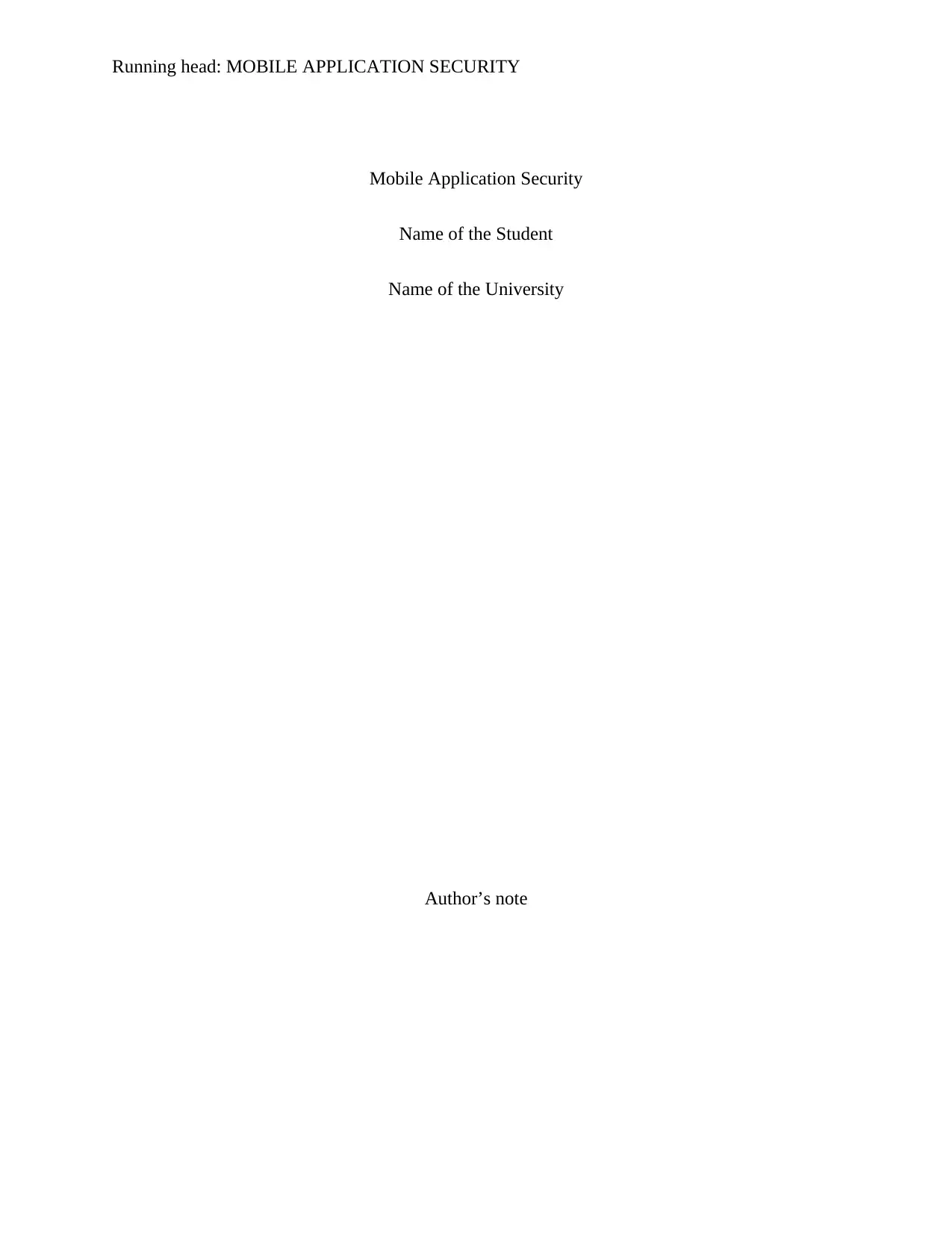
Running head: MOBILE APPLICATION SECURITY
Mobile Application Security
Name of the Student
Name of the University
Author’s note
Mobile Application Security
Name of the Student
Name of the University
Author’s note
Paraphrase This Document
Need a fresh take? Get an instant paraphrase of this document with our AI Paraphraser
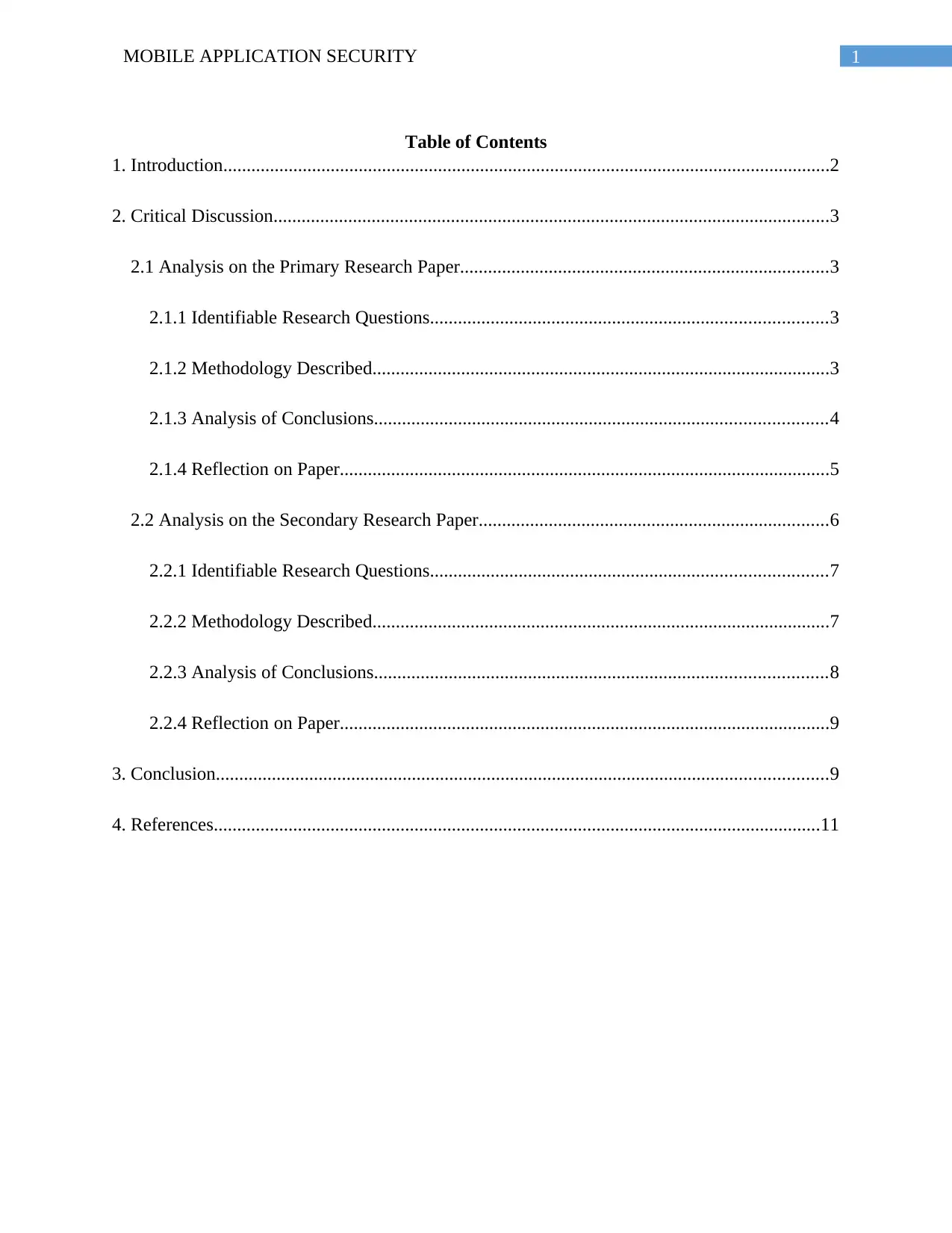
1MOBILE APPLICATION SECURITY
Table of Contents
1. Introduction..................................................................................................................................2
2. Critical Discussion.......................................................................................................................3
2.1 Analysis on the Primary Research Paper...............................................................................3
2.1.1 Identifiable Research Questions.....................................................................................3
2.1.2 Methodology Described..................................................................................................3
2.1.3 Analysis of Conclusions.................................................................................................4
2.1.4 Reflection on Paper.........................................................................................................5
2.2 Analysis on the Secondary Research Paper...........................................................................6
2.2.1 Identifiable Research Questions.....................................................................................7
2.2.2 Methodology Described..................................................................................................7
2.2.3 Analysis of Conclusions.................................................................................................8
2.2.4 Reflection on Paper.........................................................................................................9
3. Conclusion...................................................................................................................................9
4. References..................................................................................................................................11
Table of Contents
1. Introduction..................................................................................................................................2
2. Critical Discussion.......................................................................................................................3
2.1 Analysis on the Primary Research Paper...............................................................................3
2.1.1 Identifiable Research Questions.....................................................................................3
2.1.2 Methodology Described..................................................................................................3
2.1.3 Analysis of Conclusions.................................................................................................4
2.1.4 Reflection on Paper.........................................................................................................5
2.2 Analysis on the Secondary Research Paper...........................................................................6
2.2.1 Identifiable Research Questions.....................................................................................7
2.2.2 Methodology Described..................................................................................................7
2.2.3 Analysis of Conclusions.................................................................................................8
2.2.4 Reflection on Paper.........................................................................................................9
3. Conclusion...................................................................................................................................9
4. References..................................................................................................................................11
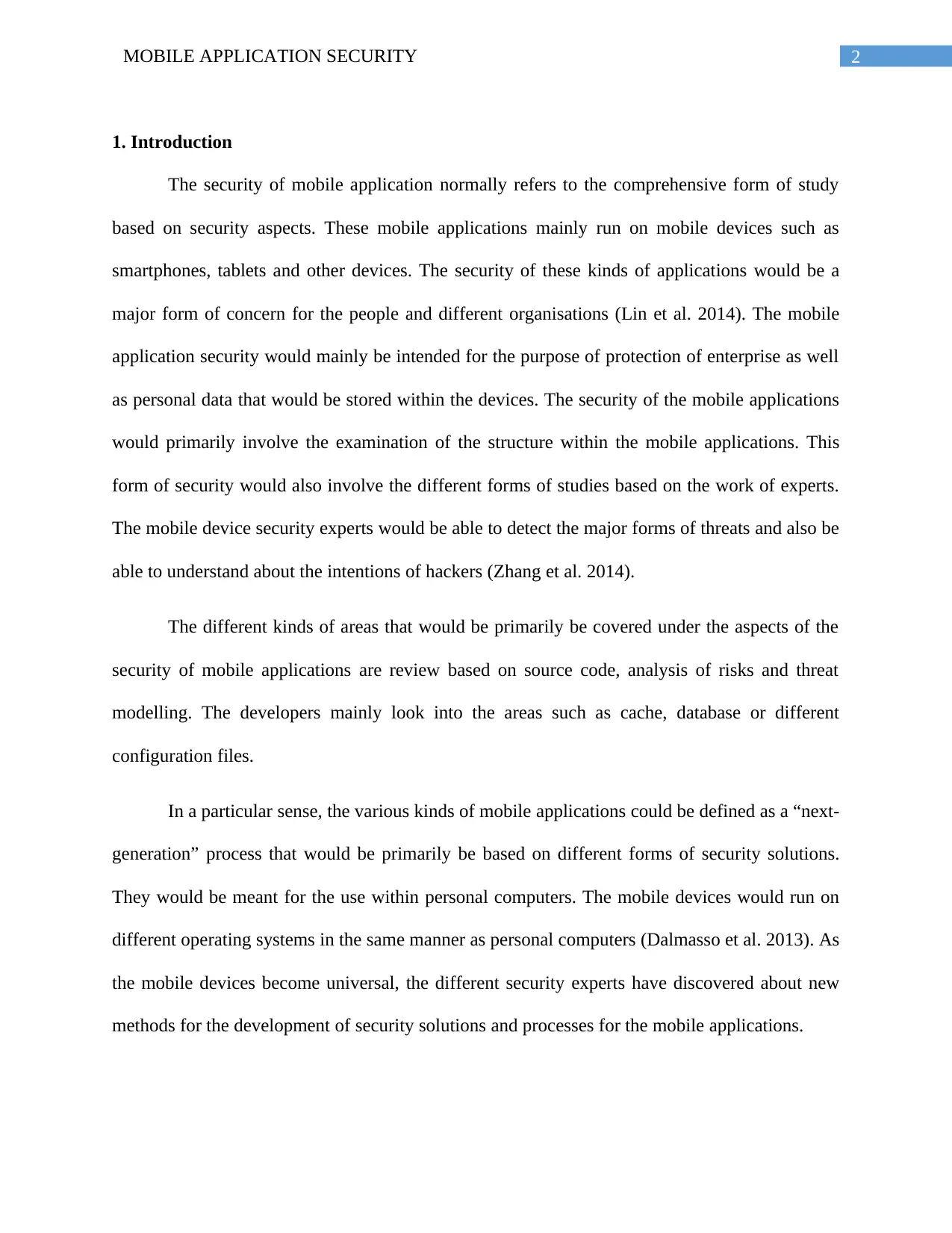
2MOBILE APPLICATION SECURITY
1. Introduction
The security of mobile application normally refers to the comprehensive form of study
based on security aspects. These mobile applications mainly run on mobile devices such as
smartphones, tablets and other devices. The security of these kinds of applications would be a
major form of concern for the people and different organisations (Lin et al. 2014). The mobile
application security would mainly be intended for the purpose of protection of enterprise as well
as personal data that would be stored within the devices. The security of the mobile applications
would primarily involve the examination of the structure within the mobile applications. This
form of security would also involve the different forms of studies based on the work of experts.
The mobile device security experts would be able to detect the major forms of threats and also be
able to understand about the intentions of hackers (Zhang et al. 2014).
The different kinds of areas that would be primarily be covered under the aspects of the
security of mobile applications are review based on source code, analysis of risks and threat
modelling. The developers mainly look into the areas such as cache, database or different
configuration files.
In a particular sense, the various kinds of mobile applications could be defined as a “next-
generation” process that would be primarily be based on different forms of security solutions.
They would be meant for the use within personal computers. The mobile devices would run on
different operating systems in the same manner as personal computers (Dalmasso et al. 2013). As
the mobile devices become universal, the different security experts have discovered about new
methods for the development of security solutions and processes for the mobile applications.
1. Introduction
The security of mobile application normally refers to the comprehensive form of study
based on security aspects. These mobile applications mainly run on mobile devices such as
smartphones, tablets and other devices. The security of these kinds of applications would be a
major form of concern for the people and different organisations (Lin et al. 2014). The mobile
application security would mainly be intended for the purpose of protection of enterprise as well
as personal data that would be stored within the devices. The security of the mobile applications
would primarily involve the examination of the structure within the mobile applications. This
form of security would also involve the different forms of studies based on the work of experts.
The mobile device security experts would be able to detect the major forms of threats and also be
able to understand about the intentions of hackers (Zhang et al. 2014).
The different kinds of areas that would be primarily be covered under the aspects of the
security of mobile applications are review based on source code, analysis of risks and threat
modelling. The developers mainly look into the areas such as cache, database or different
configuration files.
In a particular sense, the various kinds of mobile applications could be defined as a “next-
generation” process that would be primarily be based on different forms of security solutions.
They would be meant for the use within personal computers. The mobile devices would run on
different operating systems in the same manner as personal computers (Dalmasso et al. 2013). As
the mobile devices become universal, the different security experts have discovered about new
methods for the development of security solutions and processes for the mobile applications.
⊘ This is a preview!⊘
Do you want full access?
Subscribe today to unlock all pages.

Trusted by 1+ million students worldwide
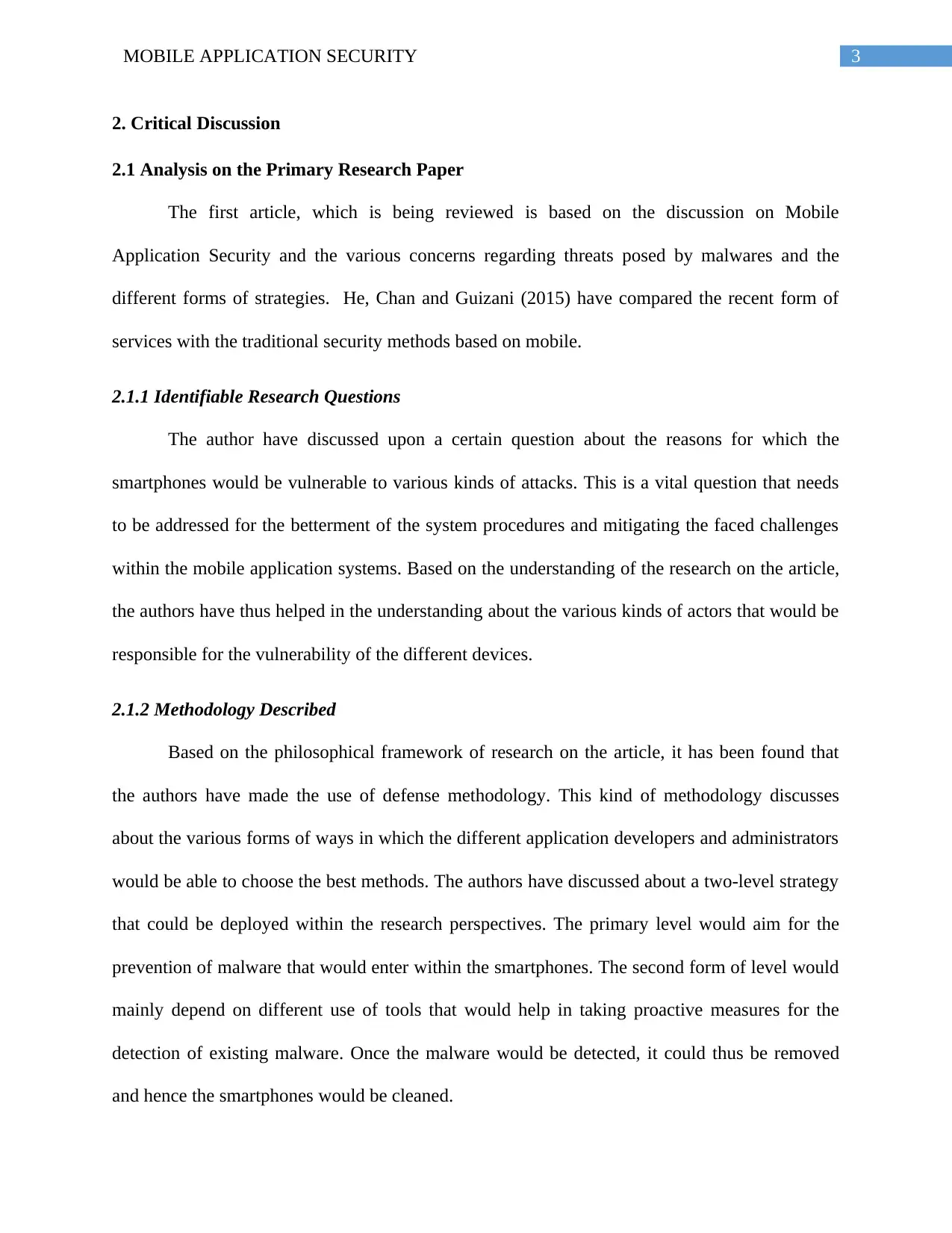
3MOBILE APPLICATION SECURITY
2. Critical Discussion
2.1 Analysis on the Primary Research Paper
The first article, which is being reviewed is based on the discussion on Mobile
Application Security and the various concerns regarding threats posed by malwares and the
different forms of strategies. He, Chan and Guizani (2015) have compared the recent form of
services with the traditional security methods based on mobile.
2.1.1 Identifiable Research Questions
The author have discussed upon a certain question about the reasons for which the
smartphones would be vulnerable to various kinds of attacks. This is a vital question that needs
to be addressed for the betterment of the system procedures and mitigating the faced challenges
within the mobile application systems. Based on the understanding of the research on the article,
the authors have thus helped in the understanding about the various kinds of actors that would be
responsible for the vulnerability of the different devices.
2.1.2 Methodology Described
Based on the philosophical framework of research on the article, it has been found that
the authors have made the use of defense methodology. This kind of methodology discusses
about the various forms of ways in which the different application developers and administrators
would be able to choose the best methods. The authors have discussed about a two-level strategy
that could be deployed within the research perspectives. The primary level would aim for the
prevention of malware that would enter within the smartphones. The second form of level would
mainly depend on different use of tools that would help in taking proactive measures for the
detection of existing malware. Once the malware would be detected, it could thus be removed
and hence the smartphones would be cleaned.
2. Critical Discussion
2.1 Analysis on the Primary Research Paper
The first article, which is being reviewed is based on the discussion on Mobile
Application Security and the various concerns regarding threats posed by malwares and the
different forms of strategies. He, Chan and Guizani (2015) have compared the recent form of
services with the traditional security methods based on mobile.
2.1.1 Identifiable Research Questions
The author have discussed upon a certain question about the reasons for which the
smartphones would be vulnerable to various kinds of attacks. This is a vital question that needs
to be addressed for the betterment of the system procedures and mitigating the faced challenges
within the mobile application systems. Based on the understanding of the research on the article,
the authors have thus helped in the understanding about the various kinds of actors that would be
responsible for the vulnerability of the different devices.
2.1.2 Methodology Described
Based on the philosophical framework of research on the article, it has been found that
the authors have made the use of defense methodology. This kind of methodology discusses
about the various forms of ways in which the different application developers and administrators
would be able to choose the best methods. The authors have discussed about a two-level strategy
that could be deployed within the research perspectives. The primary level would aim for the
prevention of malware that would enter within the smartphones. The second form of level would
mainly depend on different use of tools that would help in taking proactive measures for the
detection of existing malware. Once the malware would be detected, it could thus be removed
and hence the smartphones would be cleaned.
Paraphrase This Document
Need a fresh take? Get an instant paraphrase of this document with our AI Paraphraser
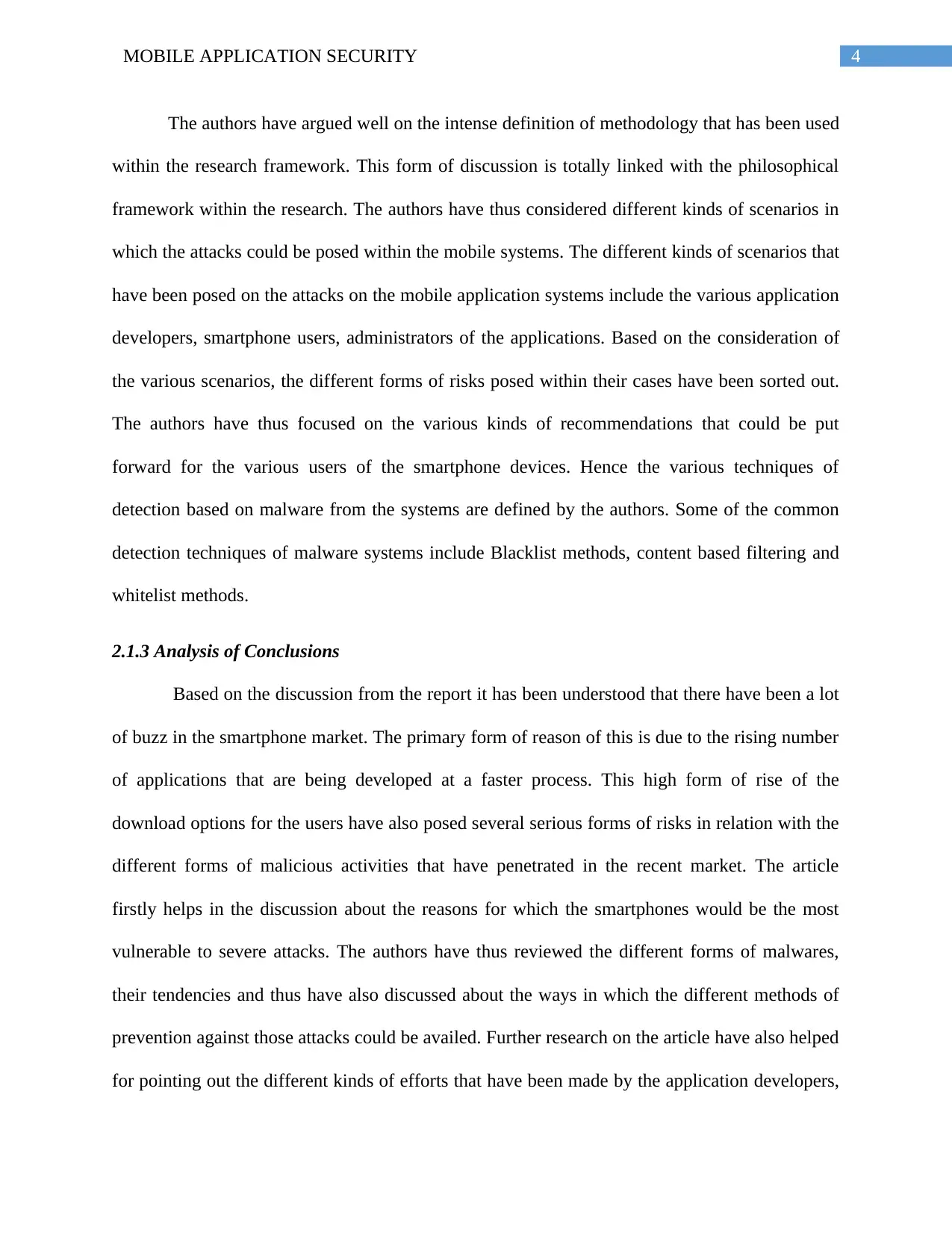
4MOBILE APPLICATION SECURITY
The authors have argued well on the intense definition of methodology that has been used
within the research framework. This form of discussion is totally linked with the philosophical
framework within the research. The authors have thus considered different kinds of scenarios in
which the attacks could be posed within the mobile systems. The different kinds of scenarios that
have been posed on the attacks on the mobile application systems include the various application
developers, smartphone users, administrators of the applications. Based on the consideration of
the various scenarios, the different forms of risks posed within their cases have been sorted out.
The authors have thus focused on the various kinds of recommendations that could be put
forward for the various users of the smartphone devices. Hence the various techniques of
detection based on malware from the systems are defined by the authors. Some of the common
detection techniques of malware systems include Blacklist methods, content based filtering and
whitelist methods.
2.1.3 Analysis of Conclusions
Based on the discussion from the report it has been understood that there have been a lot
of buzz in the smartphone market. The primary form of reason of this is due to the rising number
of applications that are being developed at a faster process. This high form of rise of the
download options for the users have also posed several serious forms of risks in relation with the
different forms of malicious activities that have penetrated in the recent market. The article
firstly helps in the discussion about the reasons for which the smartphones would be the most
vulnerable to severe attacks. The authors have thus reviewed the different forms of malwares,
their tendencies and thus have also discussed about the ways in which the different methods of
prevention against those attacks could be availed. Further research on the article have also helped
for pointing out the different kinds of efforts that have been made by the application developers,
The authors have argued well on the intense definition of methodology that has been used
within the research framework. This form of discussion is totally linked with the philosophical
framework within the research. The authors have thus considered different kinds of scenarios in
which the attacks could be posed within the mobile systems. The different kinds of scenarios that
have been posed on the attacks on the mobile application systems include the various application
developers, smartphone users, administrators of the applications. Based on the consideration of
the various scenarios, the different forms of risks posed within their cases have been sorted out.
The authors have thus focused on the various kinds of recommendations that could be put
forward for the various users of the smartphone devices. Hence the various techniques of
detection based on malware from the systems are defined by the authors. Some of the common
detection techniques of malware systems include Blacklist methods, content based filtering and
whitelist methods.
2.1.3 Analysis of Conclusions
Based on the discussion from the report it has been understood that there have been a lot
of buzz in the smartphone market. The primary form of reason of this is due to the rising number
of applications that are being developed at a faster process. This high form of rise of the
download options for the users have also posed several serious forms of risks in relation with the
different forms of malicious activities that have penetrated in the recent market. The article
firstly helps in the discussion about the reasons for which the smartphones would be the most
vulnerable to severe attacks. The authors have thus reviewed the different forms of malwares,
their tendencies and thus have also discussed about the ways in which the different methods of
prevention against those attacks could be availed. Further research on the article have also helped
for pointing out the different kinds of efforts that have been made by the application developers,
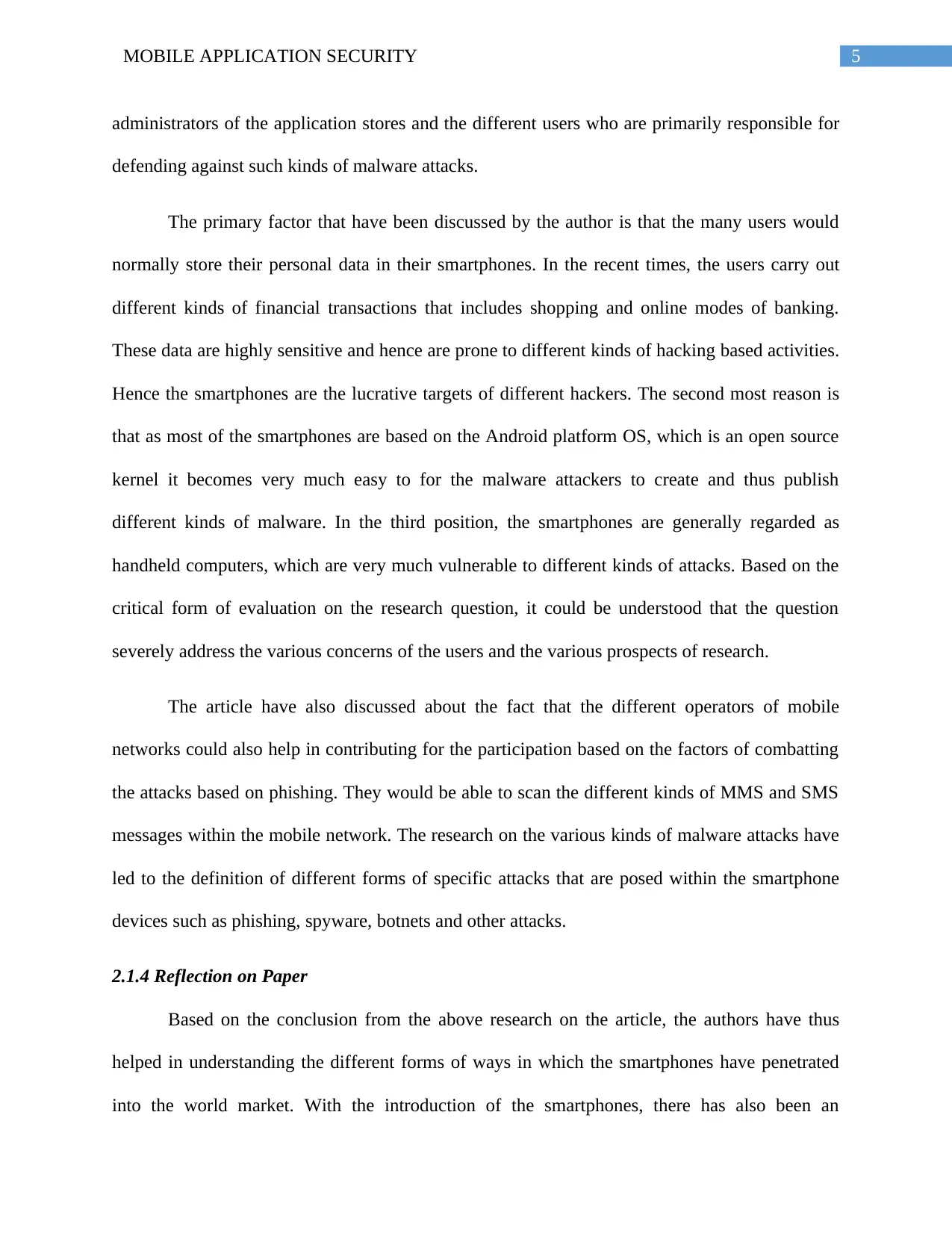
5MOBILE APPLICATION SECURITY
administrators of the application stores and the different users who are primarily responsible for
defending against such kinds of malware attacks.
The primary factor that have been discussed by the author is that the many users would
normally store their personal data in their smartphones. In the recent times, the users carry out
different kinds of financial transactions that includes shopping and online modes of banking.
These data are highly sensitive and hence are prone to different kinds of hacking based activities.
Hence the smartphones are the lucrative targets of different hackers. The second most reason is
that as most of the smartphones are based on the Android platform OS, which is an open source
kernel it becomes very much easy to for the malware attackers to create and thus publish
different kinds of malware. In the third position, the smartphones are generally regarded as
handheld computers, which are very much vulnerable to different kinds of attacks. Based on the
critical form of evaluation on the research question, it could be understood that the question
severely address the various concerns of the users and the various prospects of research.
The article have also discussed about the fact that the different operators of mobile
networks could also help in contributing for the participation based on the factors of combatting
the attacks based on phishing. They would be able to scan the different kinds of MMS and SMS
messages within the mobile network. The research on the various kinds of malware attacks have
led to the definition of different forms of specific attacks that are posed within the smartphone
devices such as phishing, spyware, botnets and other attacks.
2.1.4 Reflection on Paper
Based on the conclusion from the above research on the article, the authors have thus
helped in understanding the different forms of ways in which the smartphones have penetrated
into the world market. With the introduction of the smartphones, there has also been an
administrators of the application stores and the different users who are primarily responsible for
defending against such kinds of malware attacks.
The primary factor that have been discussed by the author is that the many users would
normally store their personal data in their smartphones. In the recent times, the users carry out
different kinds of financial transactions that includes shopping and online modes of banking.
These data are highly sensitive and hence are prone to different kinds of hacking based activities.
Hence the smartphones are the lucrative targets of different hackers. The second most reason is
that as most of the smartphones are based on the Android platform OS, which is an open source
kernel it becomes very much easy to for the malware attackers to create and thus publish
different kinds of malware. In the third position, the smartphones are generally regarded as
handheld computers, which are very much vulnerable to different kinds of attacks. Based on the
critical form of evaluation on the research question, it could be understood that the question
severely address the various concerns of the users and the various prospects of research.
The article have also discussed about the fact that the different operators of mobile
networks could also help in contributing for the participation based on the factors of combatting
the attacks based on phishing. They would be able to scan the different kinds of MMS and SMS
messages within the mobile network. The research on the various kinds of malware attacks have
led to the definition of different forms of specific attacks that are posed within the smartphone
devices such as phishing, spyware, botnets and other attacks.
2.1.4 Reflection on Paper
Based on the conclusion from the above research on the article, the authors have thus
helped in understanding the different forms of ways in which the smartphones have penetrated
into the world market. With the introduction of the smartphones, there has also been an
⊘ This is a preview!⊘
Do you want full access?
Subscribe today to unlock all pages.

Trusted by 1+ million students worldwide
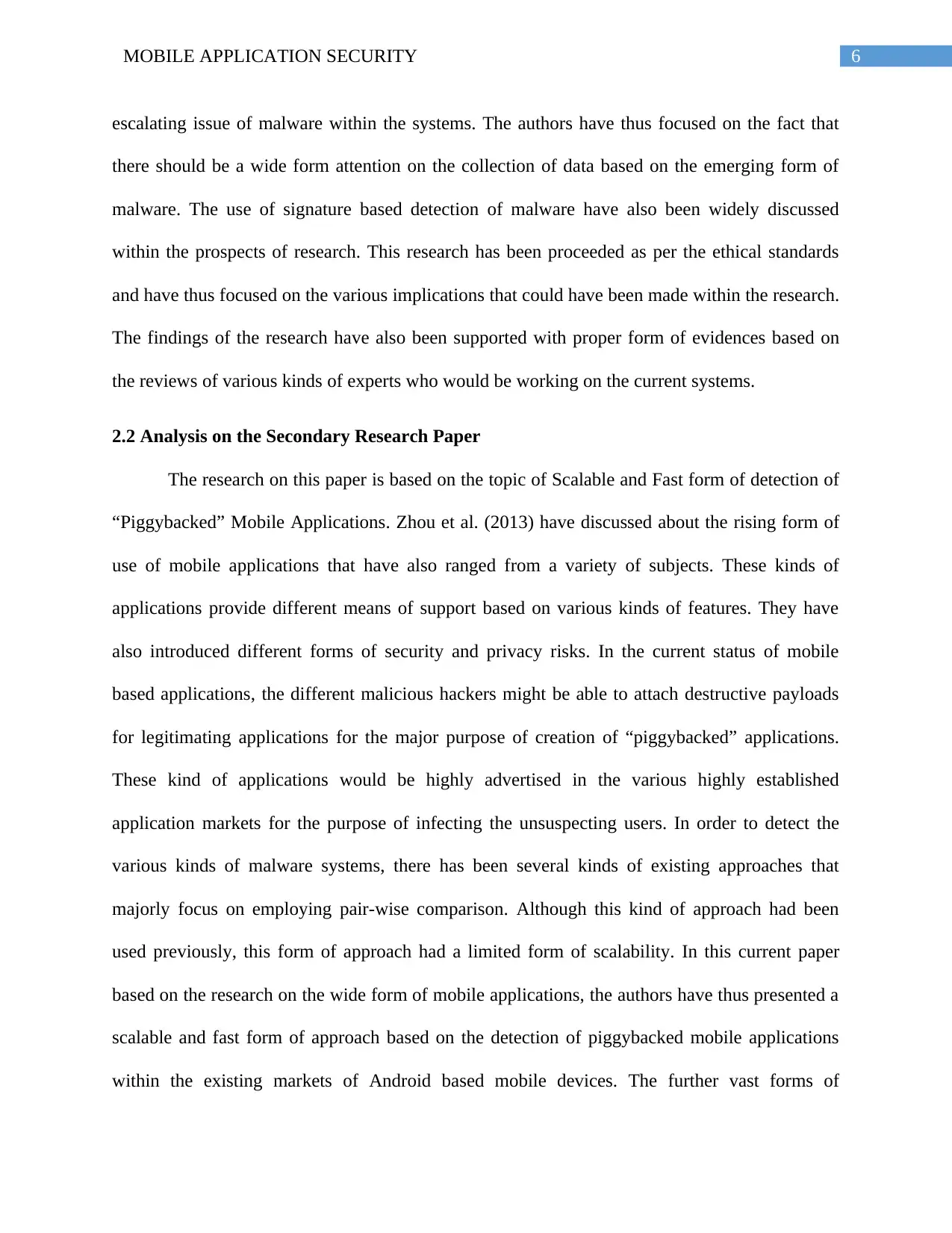
6MOBILE APPLICATION SECURITY
escalating issue of malware within the systems. The authors have thus focused on the fact that
there should be a wide form attention on the collection of data based on the emerging form of
malware. The use of signature based detection of malware have also been widely discussed
within the prospects of research. This research has been proceeded as per the ethical standards
and have thus focused on the various implications that could have been made within the research.
The findings of the research have also been supported with proper form of evidences based on
the reviews of various kinds of experts who would be working on the current systems.
2.2 Analysis on the Secondary Research Paper
The research on this paper is based on the topic of Scalable and Fast form of detection of
“Piggybacked” Mobile Applications. Zhou et al. (2013) have discussed about the rising form of
use of mobile applications that have also ranged from a variety of subjects. These kinds of
applications provide different means of support based on various kinds of features. They have
also introduced different forms of security and privacy risks. In the current status of mobile
based applications, the different malicious hackers might be able to attach destructive payloads
for legitimating applications for the major purpose of creation of “piggybacked” applications.
These kind of applications would be highly advertised in the various highly established
application markets for the purpose of infecting the unsuspecting users. In order to detect the
various kinds of malware systems, there has been several kinds of existing approaches that
majorly focus on employing pair-wise comparison. Although this kind of approach had been
used previously, this form of approach had a limited form of scalability. In this current paper
based on the research on the wide form of mobile applications, the authors have thus presented a
scalable and fast form of approach based on the detection of piggybacked mobile applications
within the existing markets of Android based mobile devices. The further vast forms of
escalating issue of malware within the systems. The authors have thus focused on the fact that
there should be a wide form attention on the collection of data based on the emerging form of
malware. The use of signature based detection of malware have also been widely discussed
within the prospects of research. This research has been proceeded as per the ethical standards
and have thus focused on the various implications that could have been made within the research.
The findings of the research have also been supported with proper form of evidences based on
the reviews of various kinds of experts who would be working on the current systems.
2.2 Analysis on the Secondary Research Paper
The research on this paper is based on the topic of Scalable and Fast form of detection of
“Piggybacked” Mobile Applications. Zhou et al. (2013) have discussed about the rising form of
use of mobile applications that have also ranged from a variety of subjects. These kinds of
applications provide different means of support based on various kinds of features. They have
also introduced different forms of security and privacy risks. In the current status of mobile
based applications, the different malicious hackers might be able to attach destructive payloads
for legitimating applications for the major purpose of creation of “piggybacked” applications.
These kind of applications would be highly advertised in the various highly established
application markets for the purpose of infecting the unsuspecting users. In order to detect the
various kinds of malware systems, there has been several kinds of existing approaches that
majorly focus on employing pair-wise comparison. Although this kind of approach had been
used previously, this form of approach had a limited form of scalability. In this current paper
based on the research on the wide form of mobile applications, the authors have thus presented a
scalable and fast form of approach based on the detection of piggybacked mobile applications
within the existing markets of Android based mobile devices. The further vast forms of
Paraphrase This Document
Need a fresh take? Get an instant paraphrase of this document with our AI Paraphraser
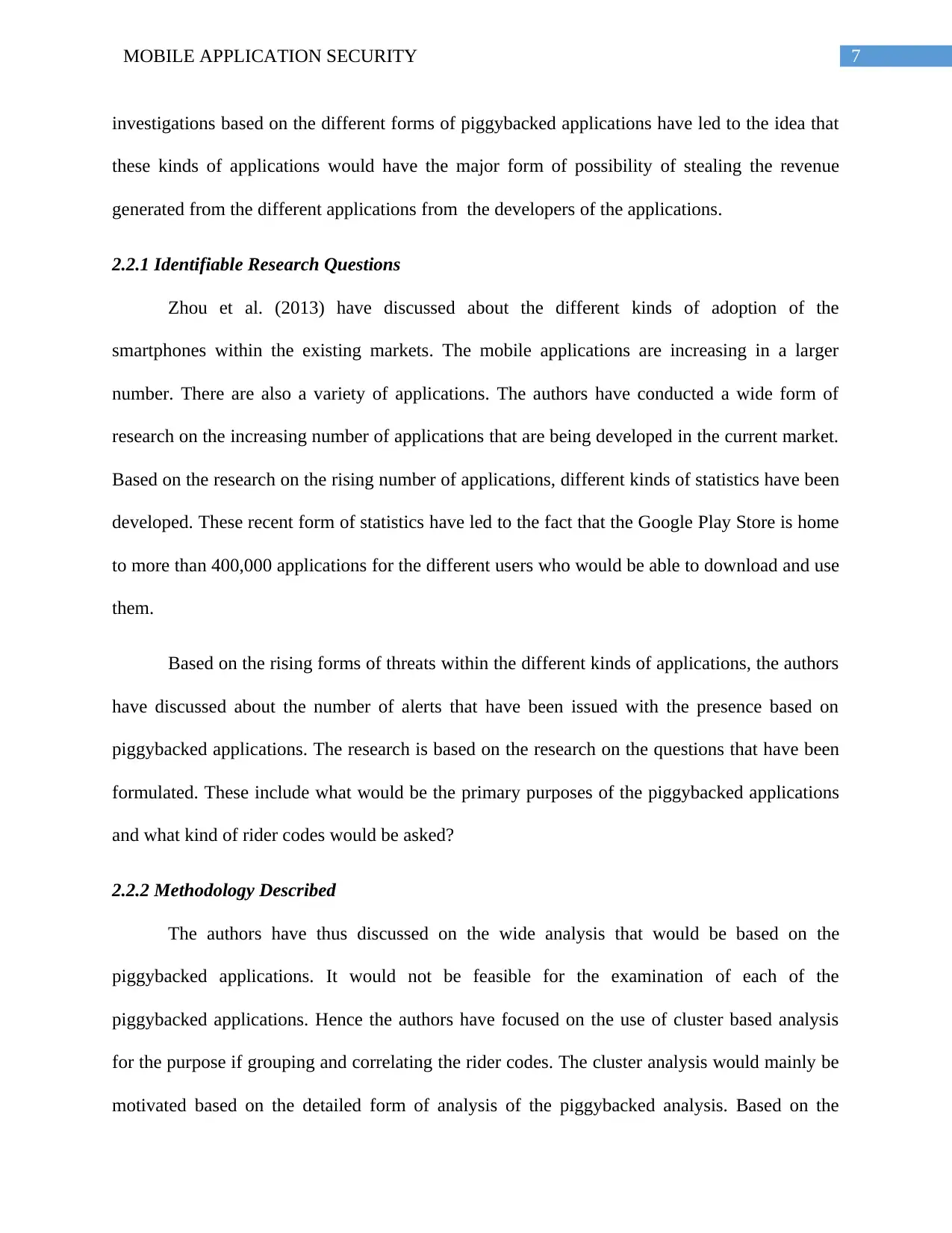
7MOBILE APPLICATION SECURITY
investigations based on the different forms of piggybacked applications have led to the idea that
these kinds of applications would have the major form of possibility of stealing the revenue
generated from the different applications from the developers of the applications.
2.2.1 Identifiable Research Questions
Zhou et al. (2013) have discussed about the different kinds of adoption of the
smartphones within the existing markets. The mobile applications are increasing in a larger
number. There are also a variety of applications. The authors have conducted a wide form of
research on the increasing number of applications that are being developed in the current market.
Based on the research on the rising number of applications, different kinds of statistics have been
developed. These recent form of statistics have led to the fact that the Google Play Store is home
to more than 400,000 applications for the different users who would be able to download and use
them.
Based on the rising forms of threats within the different kinds of applications, the authors
have discussed about the number of alerts that have been issued with the presence based on
piggybacked applications. The research is based on the research on the questions that have been
formulated. These include what would be the primary purposes of the piggybacked applications
and what kind of rider codes would be asked?
2.2.2 Methodology Described
The authors have thus discussed on the wide analysis that would be based on the
piggybacked applications. It would not be feasible for the examination of each of the
piggybacked applications. Hence the authors have focused on the use of cluster based analysis
for the purpose if grouping and correlating the rider codes. The cluster analysis would mainly be
motivated based on the detailed form of analysis of the piggybacked analysis. Based on the
investigations based on the different forms of piggybacked applications have led to the idea that
these kinds of applications would have the major form of possibility of stealing the revenue
generated from the different applications from the developers of the applications.
2.2.1 Identifiable Research Questions
Zhou et al. (2013) have discussed about the different kinds of adoption of the
smartphones within the existing markets. The mobile applications are increasing in a larger
number. There are also a variety of applications. The authors have conducted a wide form of
research on the increasing number of applications that are being developed in the current market.
Based on the research on the rising number of applications, different kinds of statistics have been
developed. These recent form of statistics have led to the fact that the Google Play Store is home
to more than 400,000 applications for the different users who would be able to download and use
them.
Based on the rising forms of threats within the different kinds of applications, the authors
have discussed about the number of alerts that have been issued with the presence based on
piggybacked applications. The research is based on the research on the questions that have been
formulated. These include what would be the primary purposes of the piggybacked applications
and what kind of rider codes would be asked?
2.2.2 Methodology Described
The authors have thus discussed on the wide analysis that would be based on the
piggybacked applications. It would not be feasible for the examination of each of the
piggybacked applications. Hence the authors have focused on the use of cluster based analysis
for the purpose if grouping and correlating the rider codes. The cluster analysis would mainly be
motivated based on the detailed form of analysis of the piggybacked analysis. Based on the
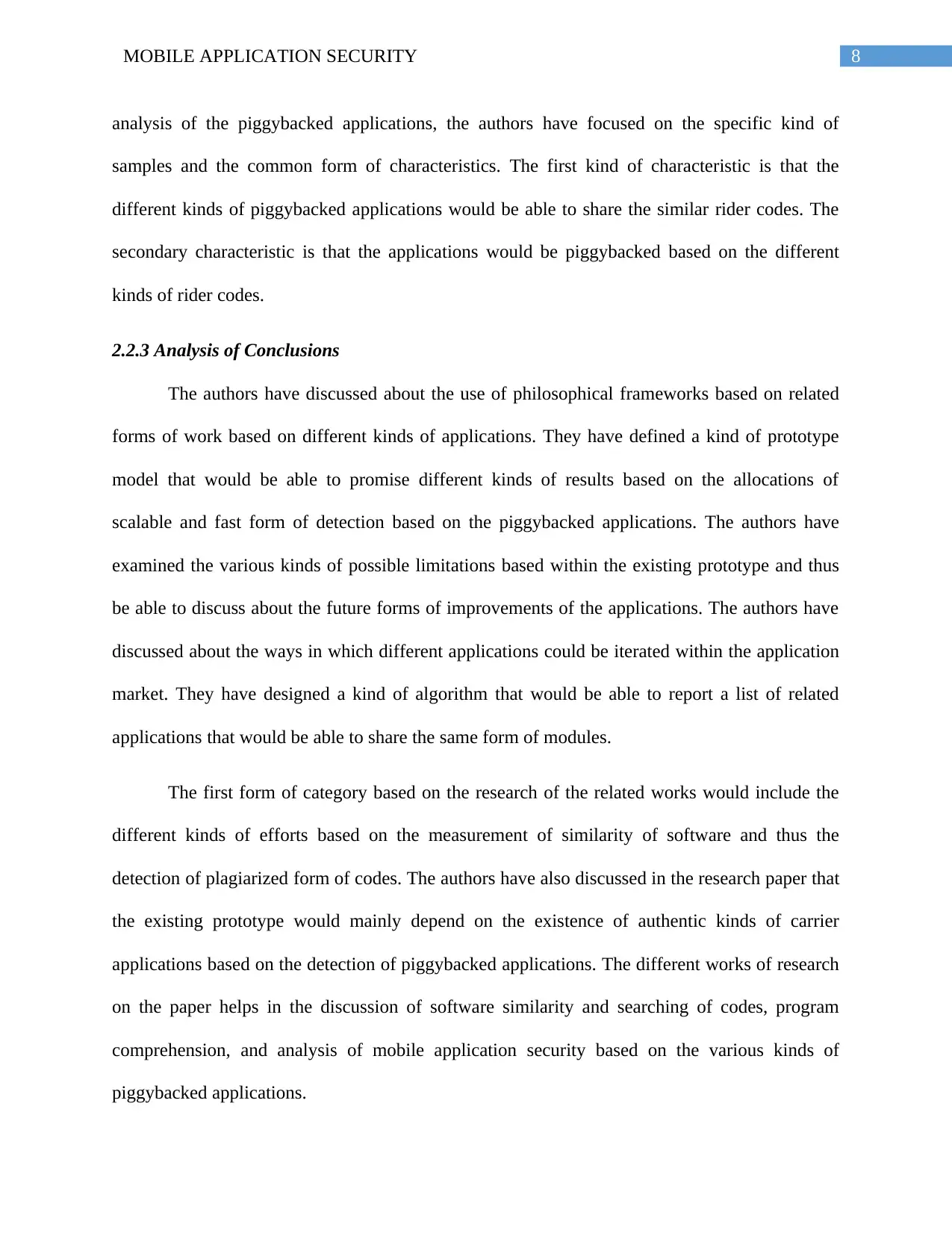
8MOBILE APPLICATION SECURITY
analysis of the piggybacked applications, the authors have focused on the specific kind of
samples and the common form of characteristics. The first kind of characteristic is that the
different kinds of piggybacked applications would be able to share the similar rider codes. The
secondary characteristic is that the applications would be piggybacked based on the different
kinds of rider codes.
2.2.3 Analysis of Conclusions
The authors have discussed about the use of philosophical frameworks based on related
forms of work based on different kinds of applications. They have defined a kind of prototype
model that would be able to promise different kinds of results based on the allocations of
scalable and fast form of detection based on the piggybacked applications. The authors have
examined the various kinds of possible limitations based within the existing prototype and thus
be able to discuss about the future forms of improvements of the applications. The authors have
discussed about the ways in which different applications could be iterated within the application
market. They have designed a kind of algorithm that would be able to report a list of related
applications that would be able to share the same form of modules.
The first form of category based on the research of the related works would include the
different kinds of efforts based on the measurement of similarity of software and thus the
detection of plagiarized form of codes. The authors have also discussed in the research paper that
the existing prototype would mainly depend on the existence of authentic kinds of carrier
applications based on the detection of piggybacked applications. The different works of research
on the paper helps in the discussion of software similarity and searching of codes, program
comprehension, and analysis of mobile application security based on the various kinds of
piggybacked applications.
analysis of the piggybacked applications, the authors have focused on the specific kind of
samples and the common form of characteristics. The first kind of characteristic is that the
different kinds of piggybacked applications would be able to share the similar rider codes. The
secondary characteristic is that the applications would be piggybacked based on the different
kinds of rider codes.
2.2.3 Analysis of Conclusions
The authors have discussed about the use of philosophical frameworks based on related
forms of work based on different kinds of applications. They have defined a kind of prototype
model that would be able to promise different kinds of results based on the allocations of
scalable and fast form of detection based on the piggybacked applications. The authors have
examined the various kinds of possible limitations based within the existing prototype and thus
be able to discuss about the future forms of improvements of the applications. The authors have
discussed about the ways in which different applications could be iterated within the application
market. They have designed a kind of algorithm that would be able to report a list of related
applications that would be able to share the same form of modules.
The first form of category based on the research of the related works would include the
different kinds of efforts based on the measurement of similarity of software and thus the
detection of plagiarized form of codes. The authors have also discussed in the research paper that
the existing prototype would mainly depend on the existence of authentic kinds of carrier
applications based on the detection of piggybacked applications. The different works of research
on the paper helps in the discussion of software similarity and searching of codes, program
comprehension, and analysis of mobile application security based on the various kinds of
piggybacked applications.
⊘ This is a preview!⊘
Do you want full access?
Subscribe today to unlock all pages.

Trusted by 1+ million students worldwide
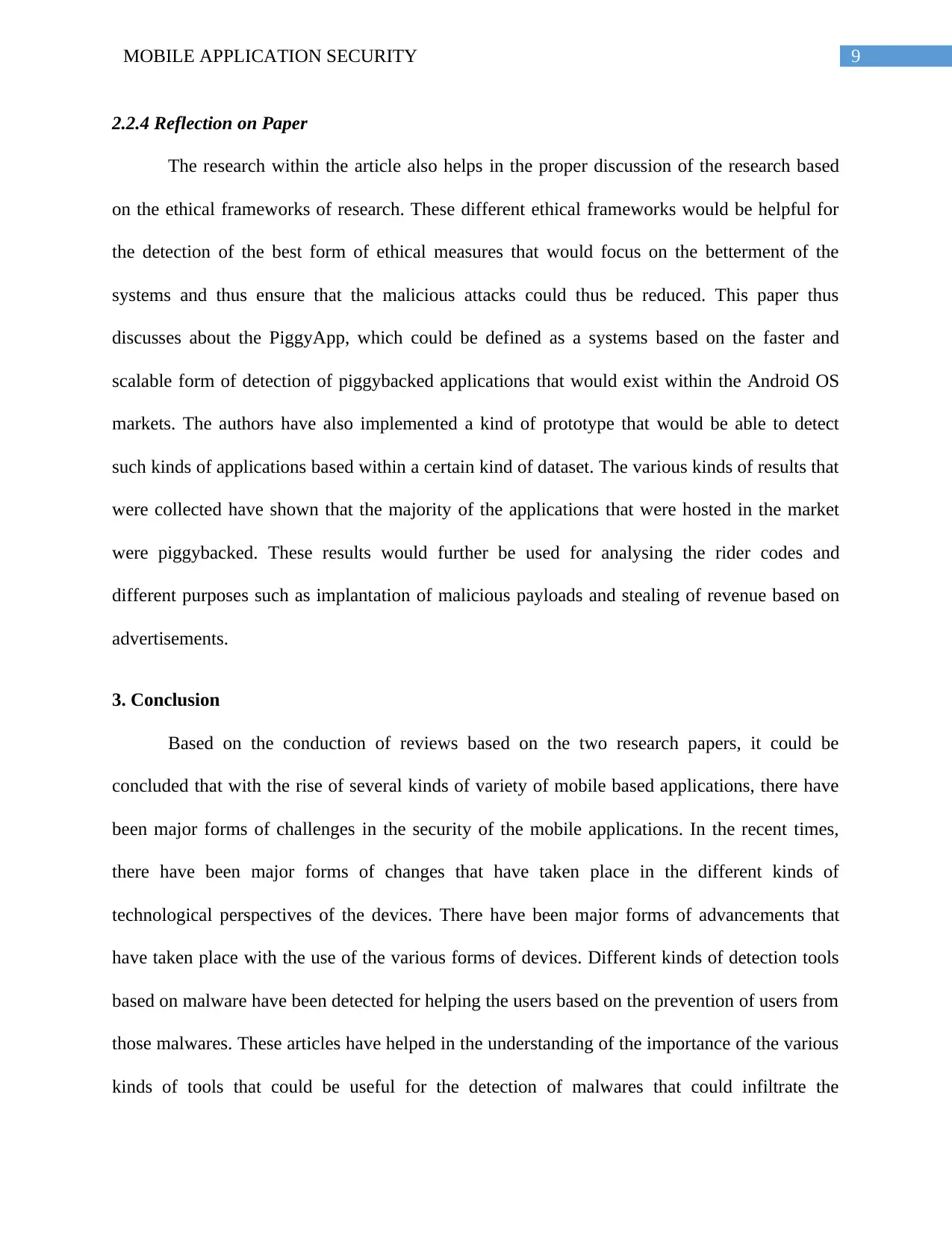
9MOBILE APPLICATION SECURITY
2.2.4 Reflection on Paper
The research within the article also helps in the proper discussion of the research based
on the ethical frameworks of research. These different ethical frameworks would be helpful for
the detection of the best form of ethical measures that would focus on the betterment of the
systems and thus ensure that the malicious attacks could thus be reduced. This paper thus
discusses about the PiggyApp, which could be defined as a systems based on the faster and
scalable form of detection of piggybacked applications that would exist within the Android OS
markets. The authors have also implemented a kind of prototype that would be able to detect
such kinds of applications based within a certain kind of dataset. The various kinds of results that
were collected have shown that the majority of the applications that were hosted in the market
were piggybacked. These results would further be used for analysing the rider codes and
different purposes such as implantation of malicious payloads and stealing of revenue based on
advertisements.
3. Conclusion
Based on the conduction of reviews based on the two research papers, it could be
concluded that with the rise of several kinds of variety of mobile based applications, there have
been major forms of challenges in the security of the mobile applications. In the recent times,
there have been major forms of changes that have taken place in the different kinds of
technological perspectives of the devices. There have been major forms of advancements that
have taken place with the use of the various forms of devices. Different kinds of detection tools
based on malware have been detected for helping the users based on the prevention of users from
those malwares. These articles have helped in the understanding of the importance of the various
kinds of tools that could be useful for the detection of malwares that could infiltrate the
2.2.4 Reflection on Paper
The research within the article also helps in the proper discussion of the research based
on the ethical frameworks of research. These different ethical frameworks would be helpful for
the detection of the best form of ethical measures that would focus on the betterment of the
systems and thus ensure that the malicious attacks could thus be reduced. This paper thus
discusses about the PiggyApp, which could be defined as a systems based on the faster and
scalable form of detection of piggybacked applications that would exist within the Android OS
markets. The authors have also implemented a kind of prototype that would be able to detect
such kinds of applications based within a certain kind of dataset. The various kinds of results that
were collected have shown that the majority of the applications that were hosted in the market
were piggybacked. These results would further be used for analysing the rider codes and
different purposes such as implantation of malicious payloads and stealing of revenue based on
advertisements.
3. Conclusion
Based on the conduction of reviews based on the two research papers, it could be
concluded that with the rise of several kinds of variety of mobile based applications, there have
been major forms of challenges in the security of the mobile applications. In the recent times,
there have been major forms of changes that have taken place in the different kinds of
technological perspectives of the devices. There have been major forms of advancements that
have taken place with the use of the various forms of devices. Different kinds of detection tools
based on malware have been detected for helping the users based on the prevention of users from
those malwares. These articles have helped in the understanding of the importance of the various
kinds of tools that could be useful for the detection of malwares that could infiltrate the
Paraphrase This Document
Need a fresh take? Get an instant paraphrase of this document with our AI Paraphraser
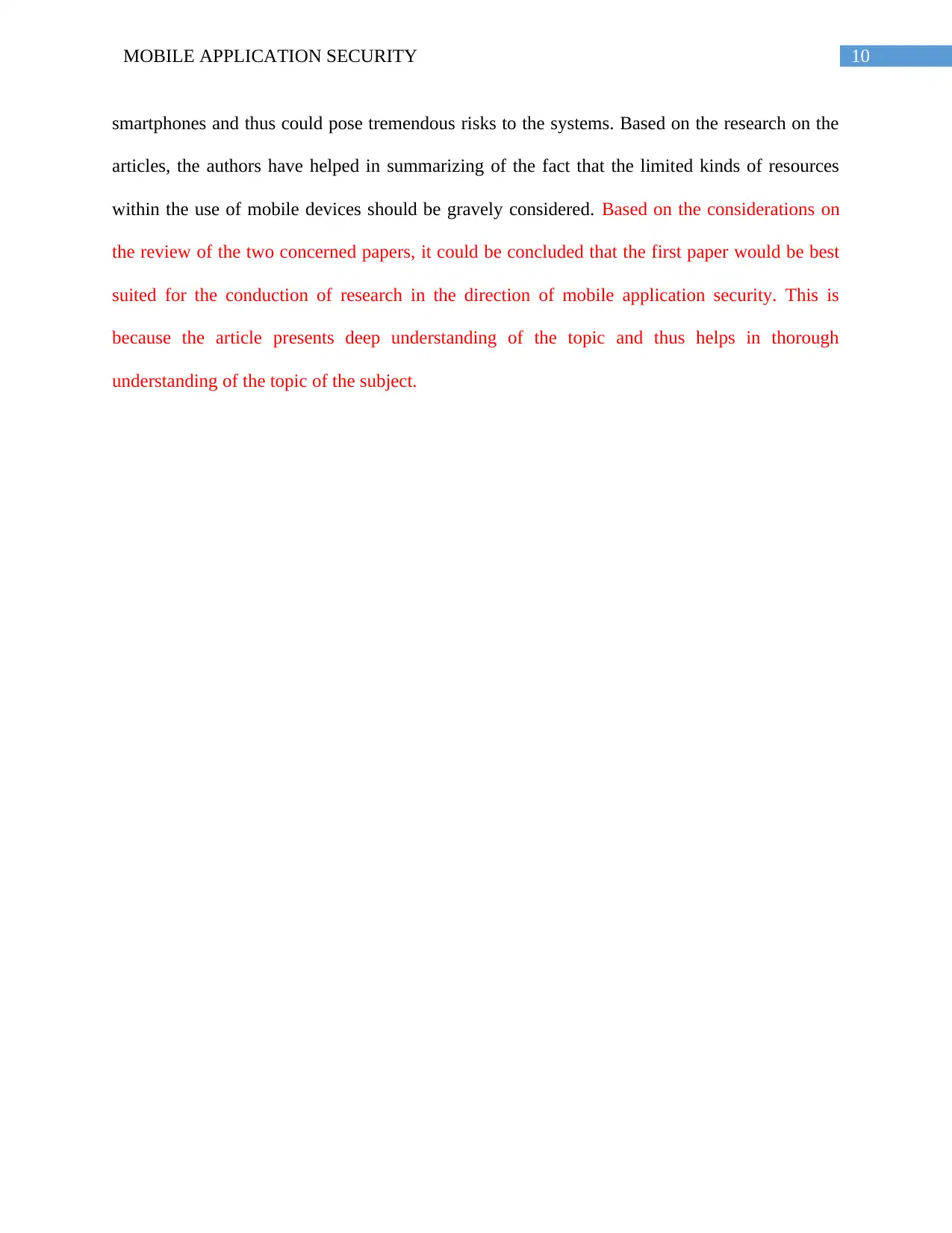
10MOBILE APPLICATION SECURITY
smartphones and thus could pose tremendous risks to the systems. Based on the research on the
articles, the authors have helped in summarizing of the fact that the limited kinds of resources
within the use of mobile devices should be gravely considered. Based on the considerations on
the review of the two concerned papers, it could be concluded that the first paper would be best
suited for the conduction of research in the direction of mobile application security. This is
because the article presents deep understanding of the topic and thus helps in thorough
understanding of the topic of the subject.
smartphones and thus could pose tremendous risks to the systems. Based on the research on the
articles, the authors have helped in summarizing of the fact that the limited kinds of resources
within the use of mobile devices should be gravely considered. Based on the considerations on
the review of the two concerned papers, it could be concluded that the first paper would be best
suited for the conduction of research in the direction of mobile application security. This is
because the article presents deep understanding of the topic and thus helps in thorough
understanding of the topic of the subject.
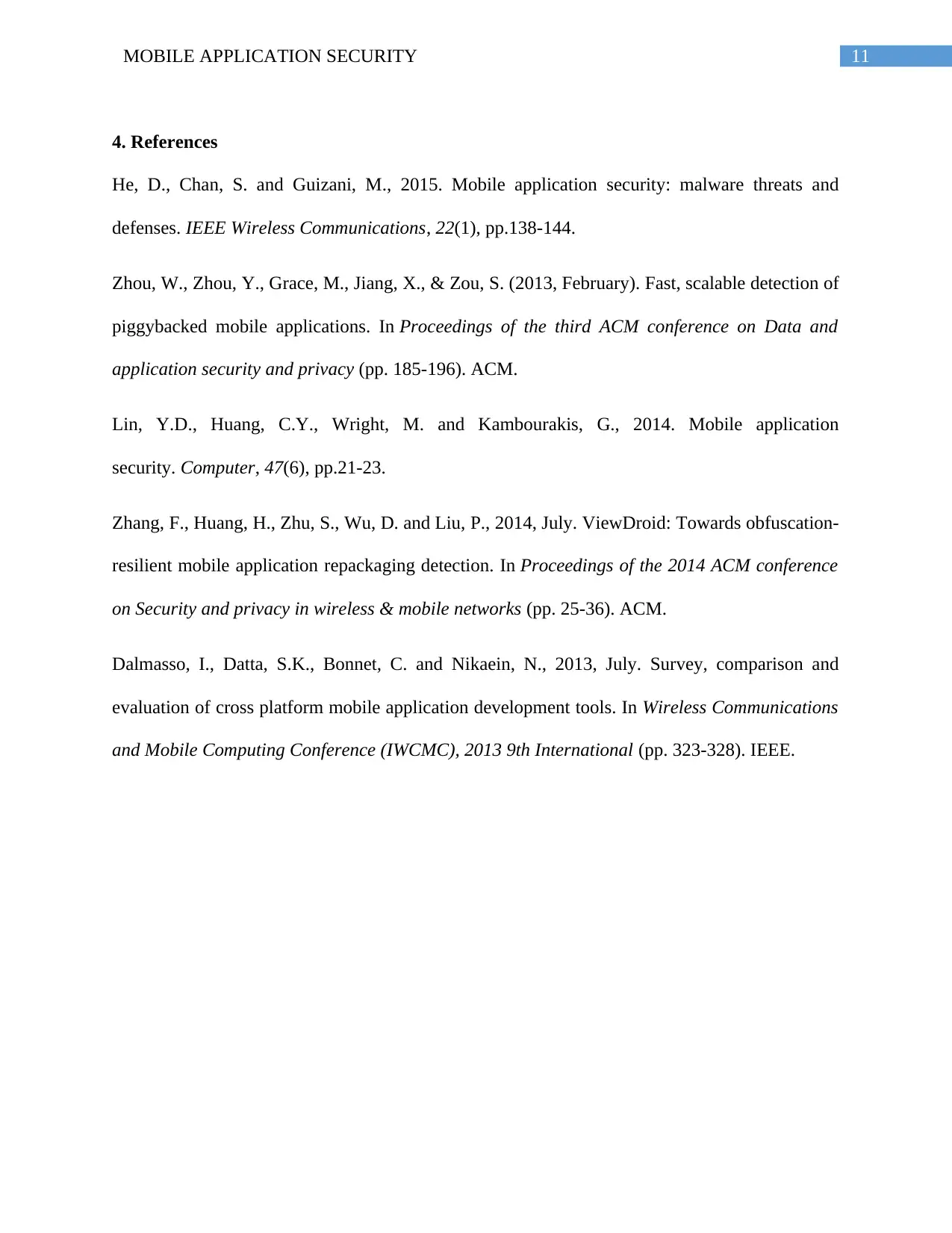
11MOBILE APPLICATION SECURITY
4. References
He, D., Chan, S. and Guizani, M., 2015. Mobile application security: malware threats and
defenses. IEEE Wireless Communications, 22(1), pp.138-144.
Zhou, W., Zhou, Y., Grace, M., Jiang, X., & Zou, S. (2013, February). Fast, scalable detection of
piggybacked mobile applications. In Proceedings of the third ACM conference on Data and
application security and privacy (pp. 185-196). ACM.
Lin, Y.D., Huang, C.Y., Wright, M. and Kambourakis, G., 2014. Mobile application
security. Computer, 47(6), pp.21-23.
Zhang, F., Huang, H., Zhu, S., Wu, D. and Liu, P., 2014, July. ViewDroid: Towards obfuscation-
resilient mobile application repackaging detection. In Proceedings of the 2014 ACM conference
on Security and privacy in wireless & mobile networks (pp. 25-36). ACM.
Dalmasso, I., Datta, S.K., Bonnet, C. and Nikaein, N., 2013, July. Survey, comparison and
evaluation of cross platform mobile application development tools. In Wireless Communications
and Mobile Computing Conference (IWCMC), 2013 9th International (pp. 323-328). IEEE.
4. References
He, D., Chan, S. and Guizani, M., 2015. Mobile application security: malware threats and
defenses. IEEE Wireless Communications, 22(1), pp.138-144.
Zhou, W., Zhou, Y., Grace, M., Jiang, X., & Zou, S. (2013, February). Fast, scalable detection of
piggybacked mobile applications. In Proceedings of the third ACM conference on Data and
application security and privacy (pp. 185-196). ACM.
Lin, Y.D., Huang, C.Y., Wright, M. and Kambourakis, G., 2014. Mobile application
security. Computer, 47(6), pp.21-23.
Zhang, F., Huang, H., Zhu, S., Wu, D. and Liu, P., 2014, July. ViewDroid: Towards obfuscation-
resilient mobile application repackaging detection. In Proceedings of the 2014 ACM conference
on Security and privacy in wireless & mobile networks (pp. 25-36). ACM.
Dalmasso, I., Datta, S.K., Bonnet, C. and Nikaein, N., 2013, July. Survey, comparison and
evaluation of cross platform mobile application development tools. In Wireless Communications
and Mobile Computing Conference (IWCMC), 2013 9th International (pp. 323-328). IEEE.
⊘ This is a preview!⊘
Do you want full access?
Subscribe today to unlock all pages.

Trusted by 1+ million students worldwide
1 out of 12
Related Documents
Your All-in-One AI-Powered Toolkit for Academic Success.
+13062052269
info@desklib.com
Available 24*7 on WhatsApp / Email
![[object Object]](/_next/static/media/star-bottom.7253800d.svg)
Unlock your academic potential
Copyright © 2020–2025 A2Z Services. All Rights Reserved. Developed and managed by ZUCOL.




